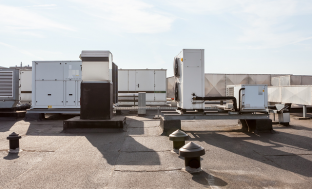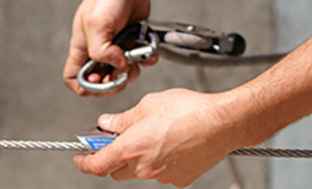latest news
Why recertification is vital: personal fall protection

In last week’s blog, we took a look at the importance of having your collective fall protection systems recertified. This week, we’re going to look at why it is just as important to get personal fall protection systems, like fall arrest and fall restraint, inspected annually also.
How are fall arrest and fall restraint systems different to collective protection?
Collective protection includes systems such as guardrails. These are known as ‘collective’ protection as they do not require the worker to actively use them or be trained in their use.
Personal protection is wholly dependent on the user, providing individual safety protection, usually in the form of anchorage points, lanyards and full body harnesses. It is important to remember that according to the work at height hierarchy of control, fall arrest and restraint should only be used as a last resort.
What can happen if systems aren’t regularly inspected?
Personal fall protection systems can often be removed, damaged, tampered with or even deployed. This can lead to the system failing when it is needed, and can cause serious injury or death, as well as a multitude of legal problems for the person who was responsible for overall safety.
All fall protection systems should be checked visually before use, alongside regular recertification by a trained and competent person. We recommend that recertification is carried out every 12 months.
We regularly inspect, and fail, systems that are not up to scratch and could lead to serious consequences.

#1 This portable deadweight anchor in Bishopbriggs had no rubber base. This rubber is a critical part of the system as it not only prevents damage to the roof but it also increase the frictional tension of the anchorage system. If the rubber is missing the system could move significantly when arresting a fall. Whenever a system has been used to arrest a fall it must be immediately taken out of action as once deployed it’s no longer safe to use.

#2 The anchor point for this lifeline system in Linlithgow is not secured properly. Whether this is due to poor installation, or overuse, we don’t know. Either way, this would likely not have been able to take the weight of the average worker if they were to fall from the roof, and could have caused them serious injury, or worse.
What is looked at during an inspection?
Competent inspection and rectification of equipment should include the following areas:a detailed inspection of the structural connection of the system such as posts and end anchors to make sure they’re secure
- pull testing of swage terminations as outlined in the manufacturer’s recommendations
- pull testing of all visible end fixings to concrete/brickwork/ structure
- checking that the system runs smoothly over all intermediate brackets
- inspection of all shock absorbers
- examination of the cable for any damage, kinks or signs of wear
- checking and tightening of all accessible fixings
- checking for any signs of corrosion to galvanised components
- re-tensioning of the cable if required
What about PPE?
Any personal protective equipment must also be inspected with the system itself, to make sure it is in good order and that every piece is compatible. It is important to note that a detailed inspection is required at least every six months, but you should also inspect the system thoroughly before each use.
PPE inspections should include:
If the PPE is used more frequently, then interim inspections would be required every three months.
- inspecting lanyards and harnesses for signs of damages such as cuts, stains, fraying or breaks in stitching
- checking for damage to fittings (e.g.karabiners, screwlink connectors, scaffold hooks)
- checking for damage to the sheath and core of a kernmantel rope
All fall protection equipment is vital and required when working at height, and all systems both collective and personal need to be regularly inspected and recertified.
Remember, if you have any concerns about the safety of your fall protection systems, do not use it and instead seek the help of a professional. Roof Edge offers inspection and recertification services. To find out more, get in touch.





